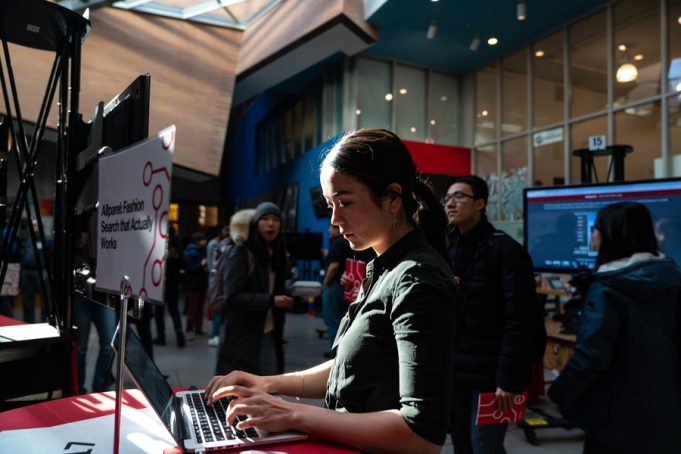Taking the lead in shaping the future of computing and artificial intelligence
Popular expo highlights student creativity and ambition as celebration of the MIT Schwarzman College of Computing gets underway.
With a box of popcorn in one hand, Hal Abelson, a renowned computer scientist, strolled through the first floor of the Ray and Maria Stata Center studying the machine learning exhibits that surrounded him on the afternoon of Feb. 26. Everywhere he looked he saw evidence of the remarkable things MIT students can do when given access to computing resources.
“Computing tools and infrastructure have gotten to a place where students can outperform professional researchers. You are constrained mostly by your imagination. It’s just an amazing time,” said Abelson, the Class of 1922 Professor of Computer Science and Engineering.
Abelson, and a crowd of hundreds, was witnessing the kickoff of a three-day celebration of the MIT Stephen A. Schwarzman College of Computing. The afternoon event was an exposition of projects that transformed the student street lobby area of the Stata Center into a computing fairground of sorts, replete with courtesy popcorn, bubble tea, lemon squares, brownies, celebratory stickers, and a host of student exhibits that crossed disciplines, broke barriers, and inspired new thinking.
For Kadeem Khan, a graduate student in urban studies and planning and an expo participant, the day was special. “I wanted to do a project focused on machine learning and the developing world,” he said. Khan applied machine learning to generate useful insights on poverty in Nairobi by analyzing data from multiple sources, including census, satellite imagery, and data from a geographic information system.
“The poverty exhibit is an example of what I was just saying,” said Abelson. “Somehow the resources are here now to allow students to bring things to the next level.” Abeslson and Nicholas Roy, a professor of aeronautics and astronautics, CSAIL researcher, and director of the Bridge in the Quest for Intelligence, helped judge the teams during the monthlong student computing challenges leading up to yesterday.
Like Khan, MIT electrical engineering and computer science graduate student Natalie Lao embarked on a winning project with the potential to make transformative change in the world. “My background is in AI — but I’m also very interested in ethics and fairness and the risks involved when applying AI to the real world,” she said. Her team’s project uses network propagation and analysis to automatically discover and potentially halt the spread of fake news across a variety of media platforms. “We’re talking to the Department of Defense and various companies and trying to see how we can get the solution out in the world,” she said.
The MIT Schwarzman College of Computing, which represents a $1 billion commitment to addressing the global opportunities and challenges presented by the prevalence of computing and the rise of artificial intelligence, will provide students with unprecedented computing resources, including access to large data sets and the tools to learn from them. Yesterday, top entrants spoke in excited tones about the data sets they accessed during the Machine Learning Across Disciplines Challenge, which, along with the Connect Arts, Community, and Computing Challenge, was funded by the MIT-IBM Watson AI Lab.
Graduate students Agni Orfanoudaki and Antonin Dauvin, who are both studying operations research at the MIT Sloan School of Management, applied machine learning and techniques developed at MIT Operations Research Center to patient data from Boston Medical Center spanning two decades. They are developing an analytic approach to understanding the impact of different anti-hypertensive drugs.
Senior Sarah Wooders, an undergraduate in math and computer science, has collected a dataset of over 4 million product images and descriptions scraped from online sources. She then trained models to collectively label over 90 important clothing attributes and is is now building a system that can automatically label new clothing products. “It’s really exciting to see all the applications of AI,” said Wooders, also a top entrant. “My project feels like such an obvious idea but this type of system hasn’t been created yet. It seems the same thing is true for a lot of things in AI right now. And so someone like me can come along and do it.”









